
A number of new generation anchors have in recent years and decades distinguished themselves from the traditional types of days gone by. Omitting knock-offs, the Delta (late 1980s) is the last of the old generation – although a modern anchor, it is still a plow and therefore effectively just an improved CQR. The Bügel (1986) is considered be the first of the new generation, but only in the last 10 years or so have these more effective anchors started to gain commercial success and widespread popularity.
Effective anchor designs must at minimum meet the following list of requirements:
- The anchor always positions itself correctly – if it falls upside down, it automatically turns over under natural conditions
- It turns (veers) with the wind and tide without pulling free
- It offers high relative holding power and will not roll out even if dragged
- It will hold on the widest possible range of seabeds, handling the typical mud and sand bottoms well in addition to the extremes of very soft mud, very hard sand, grass and weed, kelp, and so on.
Occasionally new anchor ‘inventions’ are released to the market accompanied by an enthusiastic barrage of claims. Independent testing of these designs tends to pick up on outright failure to live up to the hype, as does the failure to attain any acceptance in the boating community. Along such lines a number of interesting looking anchors have come and gone in the past decade; despite such curiosity value, this article will skip these.
Examples of new generation anchors which have gained market recognition are the Bügel, Spade, SARCA, Bulwagga, and Rocna.
Differing approaches
Small boat anchors are most effective in an asymmetrical design, distinct to the symmetrical dual-fluke designs of history and larger vessels. An asymmetrical arrangement necessitates that the anchor will position itself in the correct attitude for setting, regardless of how it is dropped on the seabed.
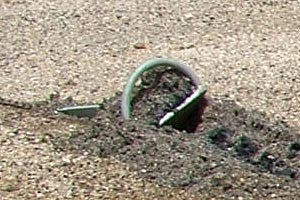
The Bügel, developed in Germany by Rolf Kaczirek, is the first of the new generation anchors, and it pioneered a novel configuration involving a semi-circular roll-bar. The weight of the fluke rolls the anchor about the roll-bar, pivoting on the shank end. The Bügel is very primitive, consisting of:
- A straight bar shank
- A roll-bar to turn anchor
- A flat fluke with sharp tip to gain rapid penetration
It represents a good development on most old generation anchors, except perhaps the Delta in some circumstances, but is hampered by its simplistic configuration and non-optimized design.
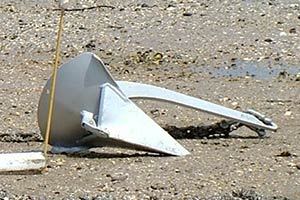
The Spade, a development of Frenchman Alain Poiraud, is almost the polar opposite of the Bügel in terms of design complexity. Omitting a roll-bar, the Spade makes use of the old generation technique of self-righting: simply place a sufficiently heavy mass in the tip, until the anchor cannot possibly sit on its back. The Spade accordingly has a lead insert built into a dedicated ballast chamber in its tip. Additionally, the shank is hollow, fabricated by plate welded together in a triangular cross-section. The fluke is concave, for maximum resistance in soft substrates. The anchor therefore consists of:
- A prominent ballast chamber with lead insert to generate tip-weight
- Hollow triangular shank profile as an attempt to retain strength as weight is removed from the shank in order to achieve the desired weight distribution (except smallest two models)
- “Ears” to prevent blade edge penetration
- Concave triangular fluke for optimum holding power, similar to previous designs by Bruce and others
The Spade is a very effective and high performing anchor, owing entirely to its efficient fluke shape which improves drastically on old plow configurations and significantly on flat fluke designs (including the Bügel). However, on a weight-for-weight basis the fluke is smaller than it might be, on account of the dedicated ballast, which cuts its potential holding power. The complicated design raises fabrication costs and it is questionable if the hollow shank is of adequate strength to handle abuse in stringent environments – the aluminium versions bend very easily indeed.
The key difference between the concepts found in the Bügel and the Spade is that the former relies on force from the anchor rode to set the anchor (assisted penetration) whilst the latter is supposed to use weight distribution and an angled ballast chamber to ensure the optimum angle for penetration (passive penetration) even before any force is applied. In fact the specially weighted tip makes little difference to its setting performance, and is present for the same reason the CQR featured a lead insert way back in 1933: to make sure it rolled over and couldn’t stay upside-down, hence the term “ballast”. The Bügel avoids this requirement by using its roll-bar, of trivial mass contribution itself, and so greater blade area or structural strength can be attained by allocating the weight of the lead to other things. Only the primitive nature of the Bügel restricts its potential.
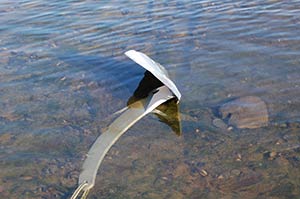
The Océane, Sword, and Raya anchors are the Spade designer’s attempted answers to the inefficiency of the ballasted Spade and its intrinsic expense, discussed here due to their connection with their big brother. The Sword is still available from the Spade manufacturer, while the latest iteration – the “Raya” – was available for a brief period from Poiraud in Brazil.
These designs attempt to omit both dedicated ballast and a roll-bar, relying on supposedly clever geometry to roll the anchor along its shank.
The Raya is the more sophisticated of the three, but it unfortunately proves something of a failure when examined carefully: it is possible for the anchor to lie on its back, from which position it will completely fail to attain the correct attitude for setting. Once in this particular position, the anchor can be dragged indefinitely and never self-right, as shown in the photo to the right.
The positioning of the shank at the tip also has negative implications for both setting performance and strength and durability (the large spread of unreinforced thin plate that forms the bulk of the anchor’s fluke behind the shank is of dubious wisdom).
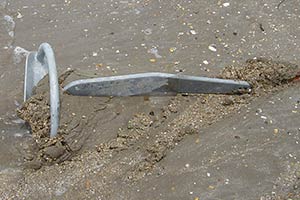
The Rocna was developed by New Zealander Peter Smith in 2000, released commercially in 2004 following strong demand developed from early models produced privately for Smith and friends. The Rocna uses a roll-bar like the Bügel, and develops the rest of the anchor to a far more sophisticated level. Both the shank and fluke are carefully optimized in order to maximize efficiency, with an eye to strength and durability. The Rocna consists of:
- A concave fluke similar in form to that of the Spade but with more surface area
- Tip-weight in the form of a thicker tip section, which keeps the tip profile slim while adding strength to the tip
- Skids to assist with setting
- Sensible shank designed to minimize early setting resistance and enable practical stowage on bow rollers.
Testing and feedback demonstrate that a well-designed roll-bar anchor such as a Rocna offers both greater holding power and setting ability than a ballasted-tip anchor such as a Spade.
For more on the development of new generation anchors, and the Rocna in particular, take a look at Rocna designer Peter Smith’s Essay on New Generation Anchors.
New generation anchors summarized
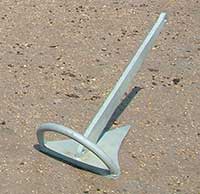 Bügel / WASI
Bügel / WASI
|
Bügel (AKA “WASI”)Bügelanker is German for “handle” or “roll-bar” anchor. It is simple design now very popular, particularly in the Mediterranean. A flat blade is shaped to form a sharp point, while a roll-bar ensures that the anchor always lands the right way up. Once a load is applied to the rode, the anchor adopts the optimum angle for penetration and its sharp point will penetrate most bottoms with ease. For:
Against:
Knock-offsUniquely, the Bügel was never properly commercialized and, aided by the design’s very simple construction, most anchors today are in fact amateur builds or one-offs knocked up by metal working shops. Many of these builds are of rather dubious nature and quality varies wildly. The only company of note that produces Bügels in a commercial regard is German steel outfit WASI, whose version is only available in 316 stainless (and therefore unfortunately both expensive and mechanically weak). |
|---|---|
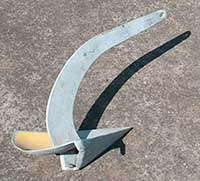 Spade
Spade
|
SpadeThis anchor was designed to be the ultimate performance anchor, but is expensive and unnecessarily complex. A spoon-shaped fluke gives good resistance but features a lead-filled ballast chamber which not only ensures that the anchor adopts the right angle for penetration, but positions a massive 50% of the anchor’s total weight over the tip. To attain this percentage, weight is removed from the shank, which is fabricated and hollow. The Spade is available in aluminium, galvanised or stainless steel. For:
Against:
Knock-offsThe Spade is expensive and complex to fabricate, making things a little difficult for the inevitable imitators, but this hasn’t stopped at least one. The Ultra is a Spade look-alike produced by Turkish manufacturer Boyut Marine, available only in 316 stainless steel. The low strength of 316 stainless aside, the design is not a precise copy and introduces a number of compromises to the Spade design. Because the Spade is a sensitive design which pushes the limits in terms of both performance and construction, it is not a type which wants to be compromised any further. |
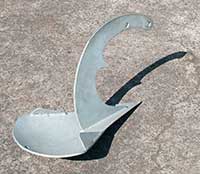 Océane/Sword
Océane/Sword
|
Océane / SwordThe last offering from Spade, the Sword used to be called the Océane but was slightly redesigned and re-branded following poor reviews and market acceptance. Its designer has since broken away from Spade and created yet a third version called the “Raya”. Like a Spade without a ballasted tip, the Sword seems to contradict the fundamental values of the Spade itself. Its shank is mounted at the tip in an attempt to give it some tip-weight, and it is much more cheaply built than the Spade. For:
Against:
|
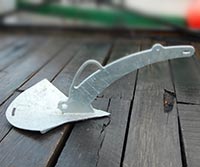 Raya
Raya
|
RayaThe third version of Alain Poiraud’s budget-Spade concept, the Raya is the most sophisticated with a re-shaped shank and improved fluke (with weighted tip care of thickened plate). It works very well once set, but unfortunately still fails in its attempt to avoid both dedicated tip ballast and a roll-bar, as it is possible for the anchor to lie upside-down partially on its side and fail to set. Like the Sword, it is much more cheaply built than the Spade and has a thin and vulnerable fluke. For:
Against:
|
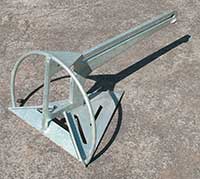 SARCA
SARCA
|
SARCAThe Sand And Rock Combination Anchor is an Australian design which features a thin roll-bar. Its classification as a new generation anchor is questionable due to its shallow convex blade (it is really a modified plow). Its shackle attachment slot runs the full length of its shank to allow the anchor to be pulled out backward if it is fouled. This is only really useful for picnic anchoring as there is always a risk that the anchor may trip itself when you don’t want it to, and it also severely weakens the shank which is made from just mild steel and already lacking in strength. For:
Against:
|
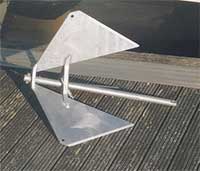 Bulwagga
Bulwagga
|
BulwaggaThe Bulwagga is an American design originally intended to work well in weed and grass. It also happens to work quite well in sand and mud. It features three flukes, two of which penetrate, and a pivoting shank which adjusts itself to the correct angle of pull. In some senses it is like a new generation Danforth, in that it has multiple flat flukes, a straight shank, and no ballast – however it performs much better and more reliably than a Danforth. For:
Against:
|
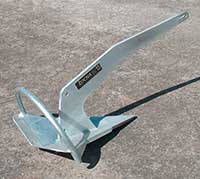 Rocna
Rocna
|
RocnaThe Rocna is a New Zealand design, at first glance a combination of a Spade’s fluke and a Bügel’s roll-bar. This is a clever mating, solving the Spade’s problems whilst remaining far more sophisticated than the Bügel. The fluke is a “folded” triangle with the tip being much thicker than the rear. These two factors give the tip enormous strength and resistance to bending. The skids are attached to the fluke in such a way that they, in addition with the roll-bar, reinforce the rear of the fluke, again providing excellent strength. The shank is designed to lock home securely on all bow-rollers. For:
Against:
Knock-offsThe Rocna quickly achieved success and made a name for itself when launched, a fact not lost on imitators. The Manson Supreme is a Rocna look-alike produced by Manson Anchors, adding to their range of CQR, Bruce, and Danforth copies (amongst others). The design is heavily compromised to lower production costs, and makes use of bizarre manufacturing techniques such as building steel thickness in strength-critical areas by welding thin plate together by the edges, rather than using the far stronger option of solid steel. Because the Rocna is a sensitive design which pushes the limits in terms of both performance and construction, it is not a type which tolerates much compromise, and tests show the Supreme to give significantly inferior performance. |
Comparison testing
In 2006, West Marine carried out an involved test of anchors on sand seabeds. They compared 14 anchor types each around 15 kg / 35 lb, in three different real world locations (with varying bottom types). In addition to the old generation plows et al, this test included a number of the newer designs.
In 2011, Practical Boat Owner in the UK published an article by Professor John Knox presenting the results of a series of very carefully controlled pull tests involving several of the more popular new generation types.
Full analyses of these tests are the subject of the Independent Anchor Performance Testing article to which the reader is directed for more detail.
